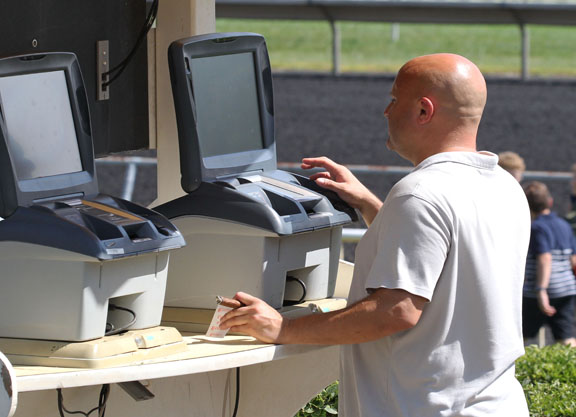By Bill Finley
As the Horseracing Integrity and Safety Act resurfaced last week as part of an omnibus spending bill passed by the House and Senate, the same questions were being asked all over again. What will the new way of doing things cost and who is going to pay for it?
All anyone really knows at this point is that the states will be expected to foot the bill and their share will depend on how much racing there is in each state. Kentucky, with year-round racing, will have to pay more than Arkansas, where Oaklawn is the only track and it is open for only about four months. A state like Pennsylvania, where there are three Thoroughbred tracks, two of which run year-round, and three harness tracks, will get hit the hardest.
It appears that each state will be left to its own devices when it comes to figuring out how to come up with an amount that will likely be in the millions for the major racing states. If that turns out to be the case, it raises the possibility that the money will come from an increase in takeout, which is the very last thing this sport needs.
While not offering any specifics, the bill suggests that the money could come from foal registration fees, sales contributions, starter fees and track fees. But taking money out of the pocket of owners, in the form of purse cuts or fees to start a horse, is another bad idea. Owners and bettors are the two most important participants in the sport and neither group can afford to have any more money come out of their pockets
Which is why the sport needs to come together and find clever and alternative ways to raise the money. Here's my idea: use the money that accrues each year from breakage.
In most states, payoffs are rounded down to the nearest 20-cent increment on a $2 bet. That means if the exact payoff on a horse to show should be $2.79, the actual payoff will be just $2.60. While a few pennies here or there may not seem like a lot, breakage can add up fast. The Thoroughbred Idea Foundation estimates that breakage adds up to about $50 million a year. During the 2018 Triple Crown alone, breakage on win bets on Justify (Scat Daddy) totaled more than $1 million for the three races.
In a perfect world, all bets would be broken down to the penny and the horse that should pay $4.18 would pay $4.18 and not $4. Horseplayers may deserve that money, but it's highly unlikely that they will ever see it. That's what makes this different from a hike in the takeout rate. Diverting breakage to pay for the Horseracing Integrity and Safety Act will not mean that the gamblers will be asked to pay any more than they are now.
Of course, that estimated $50 million has to come from somewhere. The money from breakage is used to fund such things as purses and breed development funds. In some states, the tracks are allowed to keep some or all of the money. The breakage money is retained by the bet-taker, which means more and more of that $50 million is now going to the ADW companies, which can afford to take a small hit. The money would be missed, but it is currently spread among so many entities that the hit will be minimal. And it can also be argued that this is money the tracks, breeding funds and purse accounts shouldn't be getting in the first place.
Another source of revenue could be uncashed tickets. According to the 2019 Maryland Racing Commission annual report, there were $981,618 in uncashed tickets in the state in 2019. Multiply that by the 30 or so states that have pari-mutuel wagering and you will likely come up with $10 million or so.
The breakage plus uncashed tickets, is that enough? Until The Jockey Club, the Horseracing Integrity and Safety Authority or, perhaps, the United States Anti-Doping Agency or whomever, release a budget or an estimated budget, it's impossible to tell. But even if the breakage money pays for just a fraction of the program, it is a good place to start.
The passage of the Horseracing Integrity and Safety Act, which appears to be inevitable despite President's Trump's reluctance to sign the omnibus spending bill that includes the Act, promises to be a tremendously positive, much-needed development for the sport. It will come at a cost, but that shouldn't be too much of a cost. This is not something that horseplayers should have to pay for. The same goes for the owners. Whether it's with the breakage money or something else, when it comes to paying for the Horseracing Integrity and Safety Act, the sport needs to get this one right.
Charlatan Sensational In His Return
Bob Baffert said that he thought Charlatan (Speightstown) was going to need the race in the GI Runhappy Malibu S. Saturday at Santa Anita. He could not have been more wrong.
Before being sidelined in June due to a filling in his ankle, Charlatan looked like he might be the most promising horse in racing. He demolished the competition in all three of his races, including the GI Arkansans Derby, where a medication violation cost him the official win.
What appeared to be a match race on paper, didn't really develop because the highly regarded Nashville (Speightstown) didn't run to expectations. But, nonetheless, the Malibu was loaded with talent and Charlatan thrashed his opponents, winning by 4 1/2 lengths. He got a 107 Beyer figure.
On Sunday, Baffert said he wasn't sure what was next for Charlatan. It will be interesting to see if his team shoots for the big money in races like the G1 Dubai World Cup or the Saudi Cup or gets more conservative and keeps him home. But wherever he goes, he will be the headliner. Until proven otherwise, he's the most exciting horse in the sport.
The other story out of Santa Anita Saturday was the handle. The $23,003,159 wagered was a record for an opening day at “The Great Race Place.” It sure looks like the bettors are not turning away from Southern California racing over the new, strict whipping rules.
Los Alamitos Deserved Better
The California Horse Racing Board (CHRB) should be demanding that every track in the state do its very best when it comes to safety. But the CHRB was being unreasonable when it voted to only give Los Alamitos a six-month license to run in 2021. They did so because there had been a reported 29 fatalities at the track during 2020. The commissioners said they would let Los Alamitos run during the second half of the year if they were convinced that the track had been making positive steps when it came to safety.
It's one thing to give Los Alamitos such an ultimatum. It's another thing to do so two weeks before the beginning of the year. That's especially a problem for a Quarter Horse track because most of the money for major races in the sport comes from sustaining payments. Track owner Dr. Ed Allred correctly noted that it was hard to ask Quarter Horse trainers and owners to keep making the payments when they would have no idea if any of the races scheduled later than June 30 would actually be run.
When California was desperate for a track to step up and fill the void after Hollywood Park closed down, Allred went above and beyond, converting his track so that it could hold Thoroughbred racing. Since then, it seems like he never gets a break from the CHRB. The guess is that Allred will back down, but his threat to shut the track down rather than agree to the six-month license is something that can't be taken lightly. Because of its racing dates and the fact it provides stabling for hundreds of Thoroughbreds, Los Alamitos has became a part of California racing that would be greatly missed of it were ever to go away.
The right thing to do would have been to grant Los Alamitos a one-year license while letting the track know that this would be its last chance and that there would be a stiff price to pay going forward if it didn't improve on its safety record.
Not a subscriber? Click here to sign up for the daily PDF or alerts.






